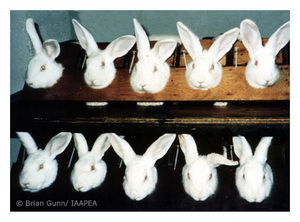Imagine your best friend cramped inside a small prison. His cries and yelps can’t be heard because his vocal cords have been surgically removed. He paces around in his cage. Isolation has caused our four legged friend to go crazy. The bumpy steel floor hurts his paws due to the pacing. This companion has never played fetch or tug of war. The only time he’s been outside is when he was brought to the laboratory as a puppy. Nobody has ever shown him affection. Instead he cowers in the corner of his cage waiting for the next test that might take his life. This is the only life he’s ever known. I believe that testing on animals is inhumane and no longer needed.
Animal testing has been around for centuries. Animal experimentation date back to the third and fourth centuries B.C. Aristotle (384-322 BC) was the “first to have made dissections which revealed internal differences among animals”. Erasistratus (304-258 BC) was most likely the first to perform experiments on live animals. Then, a Roman physician named Galen began to dissect pigs and goats. He then compared what he discovered to the knowledge that he had on human anatomy. He is now known as the “father of vivisection.” While the word vivisection literally means the dissection of live animals, the conventional definition is any research involving live nonhuman animals.
According to the 2002 US Department of Agriculture (USDA) Animal Care Report, the last such report published on the USDA’s Animal Care web site, the total number of animals used in research in the United States during that year was 1,137,718. However, this number does not include birds, mice and rats, which make up an estimated 85% of research animals used. Therefore, estimates indicate that 23-25 million animals are used in research per year in the United States alone. Species of animals reported to the USDA include: dogs, cats, primates, guinea pigs, hamsters, rabbits, sheep, pigs, and other farm animals. The total number of primates used in research in the United States during 2002 was 52,279. Between 1973 and 2002, the number of primates used in research has ranged from a minimum of 36,202 (1975) to a maximum of 61,392 (1987) per year.”
The most obscene animal experiment that I came across, dealt with smoking. Cigarette companies use animals to test the dangers of smoking. They cut holes in beagles’ throats so the dogs are forced to breathe concentrated cigarette smoke nonstop for an entire year. They also place monkeys in restraining devices with specially built masks that force monkeys to smoke the cigarettes. Pregnant monkeys are forced to smoke. Then the babies are killed and have their lungs dissected to observe what damage has been done. This research has been going on for 50 years and still continues. This research is unreliable. Blogcritics Magazine states that, “The differences between species will be greater and more difficult to compensate for exactly in those areas which interest animal researchers. This is the case, for example, in metabolic differences between species, which are centrally important in toxicological and teratological investigations.” An animals DNA is different from ours. Even the slightest difference will affect how they react to certain chemicals.
We already have the facts. We already know that nicotine is addictive. We already know that smoking causes cancer of the lungs, esophagus, larynx, tongue, salivary glands, mouth, and pharynx. We know that smoking affects babies during pregnancy, and yet these tests still continue on.
Another brutal and inhumane animal experimentation is called the Draize test. It’s used to record the harmfulness of hosehold chemicals. The Draize Test is used on white albino rabbits. They use albino rabbits because they are inexpensive, have large eyes and easy to handle. The laboratory technicians apply the chemicals into the rabbits. Clips are then placed onto the eyes to prevent the animals from blinking the chemicals away. The chemicals are left in their eyes for 14 days. These chemicals cause swollen eyelids, irritated and cloudy eyes, and inflamed skin around the eyes, and in the case of irreversible corrosive damage, they may endure ulcers, bleeding, or blindness. Once the tests are finished, the rabbits are killed.
Tests such as this are very inaccurate because a rabbits eyes are different from a humans. “The rabbit’s threshold of pain in the eye is much higher than that of humans, so irritating substances are not washed away as readily. The rabbit epithelial layer is 10 times more permeable to hydrophilic solutes than the human eye.” Since the rabbits eyes are anatomically different from a humans, the effects would be different if it were conducted on a human. Also I feel that it is pointless to keep the product in their eyes for such a long period. If a person accidentally got shampoo in their eyes, they would naturally try to flush the chemicals out right away. The pain they go through for no beneficial reason really isn’t necessary.
The second form of Draize test, is when scientists test chemicals on shaved rabbits. They also perform this on abraded skin. The chemicals are left on the area while the rabbits are placed in restraining devices. The chemicals cause intense pain, burning and itching.
The manufacturers of cosmetics and household products claim that they perform tests on animals to ensure the safety of their products under customary use or possible abuse when in reality it is to limit the company’s liability to its customers in case of a lawsuit.
It is believed that the law requires animal testing on cosmetics. This is untrue. Animal testing on cosmetics is not required by the federal Food Drug and Cosmetic Act. However, the Food and Drug Administration (FDA) does urge companies to conduct whatever toxicological tests are appropriate to substantiate the safety of their products. As a result, millions of rabbits and other animals continue to be the innocent victims of painful eye and skin irritancy tests. In other words, the main reason why these tests are conducted is to decrease customer lawsuits against the companies. When certain household cleaners and soaps first came out into the market, I believe that testing was needed. But now that we’ve gained this knowledge and know that chlorine and isopropyl alcohol causes damage if swallowed or placed in your eyes.
Another toxicity test is called the LD50. It stands for the lethal dose that kills 50% of a population within a certain time period. Rats are force fed the chemicals. It causes pain, diarrhea, convulsions, discharge, bleeding from the eyes and mouth and eventually death. At the end of the tests, the rats who haven’t died yet are killed. This test is now banned in the US and certain parts of the UK.
Then there’s animal testing where animals aren’t harmed. This seems practically unheard of based on my research. In fact it technically doesn’t count as animal experimentation since the animal isn’t harmed. There is a small company called Mother’s Cupboard Bath products that tests the shampoo on two dogs. They simply shampoo the dogs then wash it off, and see how well it smells. The only difference is they shampoo their own dogs to see how it smells after being cleaned off with water. The website states that, the dogs are grateful for the bath, and that the owner tests on herself as well as family and friends.
Animal testing can also be beneficial. Every drug approved by the FDA and put out onto the market only because it was tested on animals and proven safe. Animal testing is essential because that is the only way we can discover cures for certain diseases.
According to the US-based Foundation for Biomedical Research, animal research has played a vital role in virtually every major medical advance of the last century – for both human and veterinary health. From antibiotics to blood transfusions, from dialysis to organ transplantation, from vaccinations to chemotherapy, bypass surgery and joint replacement, practically every present-day protocol for the prevention, treatment, cure and control of disease, pain and suffering is based on knowledge attained through research with lab animals.
Animal testing is also unnecessary because there is no law that requires companies to test their personal care and household products on animals before selling them to the public. The only product that is forced by the law, to test on animals, are certain types of chemicals and pharmaceutical medical products. To think that people are so cruel against animals, and there is no reason to have them ingest toxic chemicals or be used for cosmetics. Instead of using poor innocent animals for testing we can use alternatives to animal testing. Currently scientists are using synthetic skin called Corrositex and computer modeling. It’s even more accurate and less cruel than testing on animals.
The first company that changed their ways of animal testing was Revlon Cosmetics. In 1979, Revlon gave $750,000 to the Rockefeller University to research different alternatives to test their products. Different organizations such as the John Hopkins Center for the Alternatives to Animal Testing (CAAT), Toiletry and Fragrance Association, the Cosmetic, the International Foundation for Ethical Research, and the Soap and Detergent Association started their own research to develop different alternatives.
The final reason why animal testing is so cruel is because innocent animals are being abused without reason. PETA went undercover and filmed what goes on behind closed doors. In 1997, animal rights activists went undercover at Huntingdon Life Sciences. The film shows a beagle puppy being held up by the scruff of the neck and repeatedly punched in the face, and animals being taunted. The film also shows a monkey being dissected alive.
PETA also went undercover at a drug laboratory called Covance. Monkeys were slapped and choked if they refused to participate. Workers cursed at the monkeys and slammed their cages. Sick monkeys were denied care. Some monkeys were places in tiny restraining tubes, where they literally had no room to move. The workers also played loud music that frightened the animals. Because of this the monkeys went insane and constantly paced inside their small cages. I am appalled and in complete disbelief that professional staff members for this company would treat animals like this.
Today, many companies have turned from animal testing. They now feel that animal experimentation is a cruel process that leaves innocent animals dead for no apparent reason. Although many companies have agreed that it is an absurd process, animal testing still is a huge part of product testing.
Although there has been some benefit from this cruel science, I still feel like it is wrong and inhumane. In today’s intelligent scientific world, I believe that Animal testing will soon no longer be needed.






